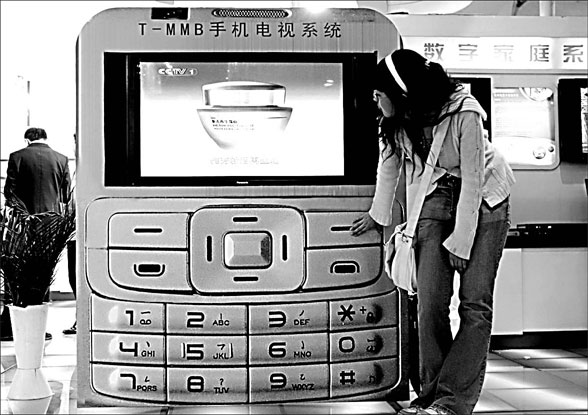


The debate over mobile TV standards is reaching a boiling point as the country's top media regulator denounces a format that had been reportedly chosen as the national standard.
On April 3, an expert evaluation group under China's Standardization Administration announced that following evaluation tests, the T-MMB format developed by Beijing Nufront Software Technology, was chosen as the national standard for mobile TV.
But the State Administration of Radio, Film and Television (SARFT), which supports a format called CMMB blasted the statement, claiming that the selection did not follow standard procedures and that SARFT will not be using T-MMB.
"The format (T-MMB) was not strictly tested or undergo necessary trials and the standardization was manipulated by a small group of people," claims Wang Xiaojie, head of SARFT's Science and Technology Department. "The result is not relevant to us and we will not adopt the standard."
Mobile TV enables cellphone carriers to provide TV services on mobile phones. The service is regarded as one of the most important "killer applications" for mobile users in the next few years and has become a lucrative area in which government institutions and companies alike want to have a bigger say.
Wang's remark received a bitter response from Nufront, which posted a statement on its website noting the tests followed the rules and that Wang's comments had no merit.
"T-MMB has shown noticeable technological advantages over other standards in the test," Nufront says.
The debate between SARFT and Nufront has cast a further shadow over the mass deployment of mobile TV in China, which has been delayed for the past few years due to the lack of a common standard.
Lou Peide, director of the multimedia communication and broadcasting standards technical committee overseen by China's Standardization Administration, says a national broadcasting standard like T-MMB still requires SARFT's support before it can be implemented, but the current circumstances make that a virtual impossibility.
China already lags behind other countries when it comes to mobile TV. Korea introduced mobile TV in 2005 and now has several million users. Japan followed in 2006 where 27 million mobile TV phones are predicted by the first half of this year. Europe and the United States also enjoy the technology.
China has been developing its less mature home-grown technoglies for mobile TV in a bid to reduce possible licensing fees charged by foreign technology vendors, which has delayed the roll-out of the services in the country.
Now the hang up is due largely between the country's top media regulator SARFT and the telecoms watchdog Ministry of Information Industry (MII), which is believed to back T-MMB.
Both government institutions are competing to have their standards adopted by the country's long delayed mobile TV network, which could have users grow at a compound annual growth rate of over 315 percent in the next four years, with the number soaring to 94 million by 2009, according to research firm In-Stat.
Differences between the standards include reception quality if the user is moving at a high rate of speed, data transmission speeds and coding formats. But essentially it has boiled down to a turf battle between the two bureaucracies.
The competition between SARFT and MII was first publicly exposed in October 2006 when SARFT announced that CMMB would be the industry standard and started establishing a CMMB-based mobile TV trial network in six Chinese cities. The network is now available in 13 cities to a select number of users and will expand to 37 cities before the Beijing Olympic.
In September 2007, SARFT even awarded six mobile TV licenses to companies that included Shanghai Media Group and CCTV, a decision that has displeased the MII.
Officials from Nufront said they have started working with some local cellphone carriers and are hoping to make the service available before the Beijing Olympics. The competition has not stopped even with alleged central government involvement.
In August last year, a spokesperson for SARFT said the Chinese government had asked SARFT to take a leading role in the development of China's mobile TV industry because it is a new form of media service. But MII officials, together with Chinese telecom operators, say they are not aware of any such request.
The government itself has made no public announcement.
In the battle over mobile TV, SARFT has more controls over content while the MII's advantage is its connections with China's more-than 500 million mobile phone users.
As China Mobile has also kicked off the pre-commercial tests for the country's controversial home-grown third generation (3G) mobile phone technology TD-SCDMA, the battle for mobile TV will become fiercer.
Editor's note: The IPR Special is sponsored by the State Intellectual Property Office and published by China Business Weekly. To contact the Intellectual Property Office, the IPR Special hotlines are 8610-64995421 or 8610-64995826, and the e-mail address is ipr@chinadaily.com.cn.
(China Daily 04/14/2008 page9)













